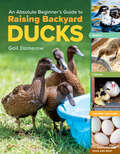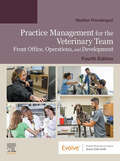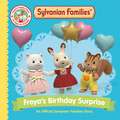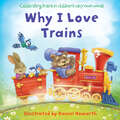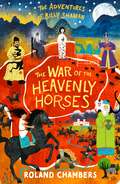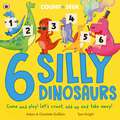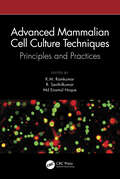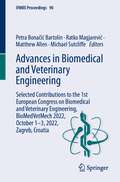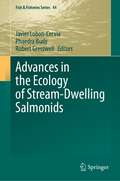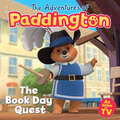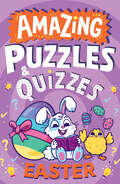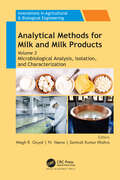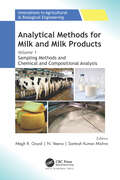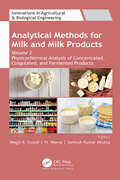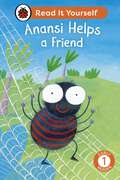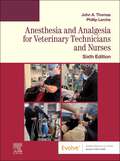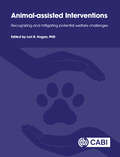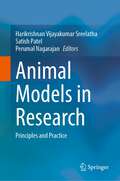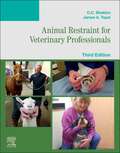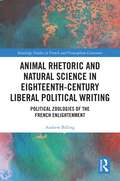- Table View
- List View
An Absolute Beginner's Guide to Raising Backyard Ducks: Breeds, Feeding, Housing and Care, Eggs and Meat
by Gail DamerowThis inspiring introductory guide provides all the information beginners need to raise ducks successfully in the yard or on a small homestead or farm. Ducks are quickly gaining on chickens as popular animals for the backyard homestead or small farm. They are friendly, productive, good at eating pests, remarkably healthy, and easier to raise than chickens in many ways. Plus, they are exceptionally adorable! This accessible introductory guide features original photography tracking the growth and care of a small flock of backyard ducks, and addresses everything the beginner duck keeper needs to know to be successful, including breed selection, housing, feeding, health care, understanding behavior, and egg and meat production. This publication conforms to the EPUB Accessibility specification at WCAG 2.0 Level AA.
Practice Management for the Veterinary Team - E-Book: Front Office, Operations, and Development
by Heather PrendergastComprehensive coverage of practice management skills includes leadership, financial management, and strategic planning, as well as telephone skills, appointment scheduling, admitting and discharging patients, and communicating with clients.Coverage of clinical assisting ranges from examinations and history-taking for patients, to kennels and boarding procedures.Veterinary Ethics and Legal Issues chapter helps you learn to protect the practice and run a practice based on ethical principles and veterinary laws.End-of-chapter review questions reinforce key concepts and measure mastery of the content.End-of-chapter Practice Managers Survival Checklist allows you to review the most essential information.Versatile text can be used by practice managers to study for the CVPM exam.Updated content highlights important technological and professional updates to the field impacting medical record management.New chapters covering telehealth and practice integrative management software are included.Current coverage includes a revised Leadership, Professional Development and Human Resources chapter and expanded content in Strategic Planning and Marketing chapters.
Sylvanian Families: An Official Sylvanian Families Story
by Macmillan Children's BooksCome and celebrate Freya the Chocolate Rabbit's birthday with all her friends in the Sylvanian Village in this sweet picture book, based on the animation Freya's Happy Diary, now showing on YouTube!It's Freya's birthday and she's having a party, but her best friends, Ralph Walnut and Lyra Persian, are nowhere to be found! As Freya searches, she meets lots of friends and neighbours who give her presents of shiny, bright balloons. So many balloons, in fact, that she's lifted right into the air!As she soars over the Sylvanian Village, she starts to wonder how she will ever get down . . . and whether her two best friends will turn up in time to help.This adorable picture book features artwork from the animated Sylvanian Families series, Freya's Happy Diary, and brings the classic and beloved toy range to life as never before.Also available: The World of Sylvanian Families: The Official Guide, Easter Search-and-Find and more!
Why I Love Trains
by Daniel HowarthFeaturing children’s own words along with heart-warming pictures, this book is a perfect celebration of all that is special about trains!
The War of the Heavenly Horses (The Adventures of Billy Shaman #2)
by Roland ChambersA new adventure series about the pivotal moments of discovery through the ages, bringing the past to life with a generous helping of fantasy, humour and delightful, black and white illustrations.Shaman by name and shaman by nature... Billy just hasn't found his magic yet... but he is learning fast.No one is more surprised than Billy when he wakes up on a Chinese battlefield. Scooped from the jaws of death by a boy called Han, Billy's far from rescued. Taking refuge in the royal stables, the boys are soon held hostage by the Emperor Wudi. He's at war with the Horse King whose powerful and magical herd of horses, the heavenly horses of Ferghana, he wants for his own. It takes all Billy's skills and a very special spirit horse to get Han to safety and Billy back to his friend Charles Darwin, a two-hundred-year-old talking tortoise.Join Billy, a new kind of explorer who sets out to return artefacts to their original home.
6 Silly Dinosaurs: a counting and number bonds picture book
by Adam Guillain Charlotte GuillainIt's time for count and seek - would you like to come and play?Let's count up all the dinosaurs and see who's here today!Count and spot the silly dinosaurs in this madcap, rhyming picture book. From T. rex magicians to dancing Diplodocus, this hilarious picture book encourages children to learn basic sums through play and interactivity.As well as basic counting and sums, this book introduces children to numbers bond and fact friends for the number 6.With playful characters to spot and bouncy rhyming text, this engaging picture book is perfect for sharing with a child to support their learning in a fun way.
Advanced Mammalian Cell Culture Techniques: Principles and Practices
This up-to-date book compiles both basic and advanced laboratory techniques of mammalian cell culture. It is divided into four major sections encompassing the basics of cell culture, nucleic acid and protein isolation, cell-staining techniques, and cell transfection and single-cell analysis. The topics include aseptic handling, media preparation, and passaging of cells. The book also outlines downstream assays such as nucleic acid and protein isolation from in-vitro cell cultures. Key Features: • Covers cellular staining using fluorescent dyes, genetic manipulation of cells via transfection, and an introduction to single-cell analyses • Discusses basics in cell culture and downstream applications including gene and protein expression analysis • Includes the principles underlying each of the techniques and provides a detailed methodology to practice • Explores the whole range of techniques – from basic to downstream applications and advanced methods The book is essential for students and researchers in the field of life sciences, biotechnology, genetics, and molecular biology.
Advanced Mammalian Cell Culture Techniques: Principles and Practices
by K. M. Ramkumar R. Senthilkumar Md Enamul HoqueThis up-to-date book compiles both basic and advanced laboratory techniques of mammalian cell culture. It is divided into four major sections encompassing the basics of cell culture, nucleic acid and protein isolation, cell-staining techniques, and cell transfection and single-cell analysis. The topics include aseptic handling, media preparation, and passaging of cells. The book also outlines downstream assays such as nucleic acid and protein isolation from in-vitro cell cultures. Key Features: • Covers cellular staining using fluorescent dyes, genetic manipulation of cells via transfection, and an introduction to single-cell analyses • Discusses basics in cell culture and downstream applications including gene and protein expression analysis • Includes the principles underlying each of the techniques and provides a detailed methodology to practice • Explores the whole range of techniques – from basic to downstream applications and advanced methods The book is essential for students and researchers in the field of life sciences, biotechnology, genetics, and molecular biology.
Advances in Biomedical and Veterinary Engineering: Selected Contributions to the 1st European Congress on Biomedical and Veterinary Engineering, BioMedVetMech 2022, October 1–3, 2022, Zagreb, Croatia (IFMBE Proceedings #90)
by Petra Bonačić Bartolin Ratko Magjarević Matthew Allen Michael SutcliffeThis book gathers selected peer-reviewed contributions to the 1st European Congress on Biomedical and Veterinary Engineering, BioMedVetMech 2022, held on October 1–3, 2022, in Zagreb, Croatia. It offers a timely snapshot of research findings and advances technologies in the area of biomechanics, rehabilitation and surgery. It covers applications of brain-computer interface, virtual reality and functional electrical stimulation, among others.
Advances in the Ecology of Stream-Dwelling Salmonids (Fish And Fisheries Ser. #44)
by Javier Lobon-Cervia Phaedra Budy Robert GresswellThe Adventures of Paddington – The Book Day Quest (The Adventures of Paddington)
by HarperCollins Children’s BooksThe perfect book to get your children excited about World Book Day!
Amazing Easter Puzzles and Quizzes (Amazing Puzzles and Quizzes for Every Kid)
by Hannah WilsonFilled with over 100 exciting Easter puzzles and quizzes for you to enjoy with friends, family or on your own!
Analytical Methods for Milk and Milk Products: Volume 3: Microbiological Analysis, Isolation, and Characterization
by Megh R. Goyal N. Veena Santosh Kumar MishraThis valuable resource on the microbiological analysis of milk and milk products delves into various aspects of bacterial enumeration, pathogen detection, mastitis milk identification, quality testing for starter cultures, isolation and characterization of lactic acid bacteria (LAB), safety assessment protocols for probiotics, DNA isolation methods, molecular characterization techniques, and statistical tools for laboratory data analysis. It presents an in-depth description of the methodologies for isolation, identification, and confirmatory tests for various hygiene and safety indicator organisms. Together with Volume 1: Sampling Methods and Chemical and Compositional Analysis and Volume 2: Physicochemical Analysis of Concentrated, Coagulated, and Fermented Products, this 3-volume work is a valuable resource on the scientific analysis of milk and milk products.
Analytical Methods for Milk and Milk Products: Volume 1: Sampling Methods and Chemical and Compositional Analysis
by Megh R. Goyal N. Veena Santosh Kumar MishraHere is a new three-volume set that comprehensively illustrates a wide range of analytical techniques and methodologies for assessing the physical, chemical, and microbiological properties of milk and milk products to ensure nutritional and technological quality and safety of milk and milk products. This volume presents the main analytical techniques and methodologies and their application to the compounds involved in nutritional and technological quality of milk and milk products. It covers the sampling methods and chemical analysis of milk, highlighting the standard methods used for calibration of different glassware, sampling procedures of milk and milk products, and the physicochemical and compositional aspects and assessment of the quality of raw milk intended for processing and manufacturing. The book describes the compositional analysis of frozen and fat-rich products, including the physicochemical and compositional analysis of dairy products that include cream, butter, butter oil, clarified fat (ghee), ice cream, and frozen desserts. Each of the laboratory exercises includes an introduction, objective, principle of method, chemicals and apparatus required, sample preparation, experimentation, data collection sheet and calculations, and resource materials. The other volumes are: Volume 2: Physicochemical Analysis of Concentrated, Coagulated, and Fermented Products Volume 3: Microbiological Analysis, Isolation, and Characterization Together, these three volumes are a complete and thorough reference on analytical methods for milk and milk products.
Analytical Methods for Milk and Milk Products: Volume 2: Physicochemical Analysis of Concentrated, Coagulated and Fermented Products
by Megh R. Goyal N. Veena Santosh Kumar MishraThis new three-volume set comprehensively illustrates a wide range of analytical techniques and methodologies for assessing the physical, chemical, and microbiological properties of milk and milk products to ensure nutritional and technological quality and safety of milk and milk products. This volume focuses on various analytical methods for physicochemical and compositional analysis of concentrated, coagulated, and fermented dairy products in detail. It also describes the standard methodologies for the analysis of nutraceutical components and food additives commonly used in various dairy products to meet technological and nutritional quality standards. The other volumes are: Volume 1: Sampling Methods, Chemical, and Compositional Analysis Volume 3: Microbiological Analysis is forthcoming. Together, these three volumes will be a complete and thorough reference on analytical methods for milk and milk products. The volumes will be valuable for researchers, scientists, food analysts, food analysis and research laboratory personnel involved in the area of milk and milk products analysis as well as for faculty and students.
Analytical Methods for Milk and Milk Products: Volume 1: Sampling Methods and Chemical and Compositional Analysis
by Megh R. Goyal N. Veena Santosh Kumar MishraHere is a new three-volume set that comprehensively illustrates a wide range of analytical techniques and methodologies for assessing the physical, chemical, and microbiological properties of milk and milk products to ensure nutritional and technological quality and safety of milk and milk products. This volume presents the main analytical techniques and methodologies and their application to the compounds involved in nutritional and technological quality of milk and milk products. It covers the sampling methods and chemical analysis of milk, highlighting the standard methods used for calibration of different glassware, sampling procedures of milk and milk products, and the physicochemical and compositional aspects and assessment of the quality of raw milk intended for processing and manufacturing. The book describes the compositional analysis of frozen and fat-rich products, including the physicochemical and compositional analysis of dairy products that include cream, butter, butter oil, clarified fat (ghee), ice cream, and frozen desserts. Each of the laboratory exercises includes an introduction, objective, principle of method, chemicals and apparatus required, sample preparation, experimentation, data collection sheet and calculations, and resource materials. The other volumes are: Volume 2: Physicochemical Analysis of Concentrated, Coagulated, and Fermented Products Volume 3: Microbiological Analysis, Isolation, and Characterization Together, these three volumes are a complete and thorough reference on analytical methods for milk and milk products.
Analytical Methods for Milk and Milk Products: Volume 3: Microbiological Analysis, Isolation, and Characterization
by Megh R. Goyal N. Veena Santosh Kumar MishraThis valuable resource on the microbiological analysis of milk and milk products delves into various aspects of bacterial enumeration, pathogen detection, mastitis milk identification, quality testing for starter cultures, isolation and characterization of lactic acid bacteria (LAB), safety assessment protocols for probiotics, DNA isolation methods, molecular characterization techniques, and statistical tools for laboratory data analysis. It presents an in-depth description of the methodologies for isolation, identification, and confirmatory tests for various hygiene and safety indicator organisms. Together with Volume 1: Sampling Methods and Chemical and Compositional Analysis and Volume 2: Physicochemical Analysis of Concentrated, Coagulated, and Fermented Products, this 3-volume work is a valuable resource on the scientific analysis of milk and milk products.
Analytical Methods for Milk and Milk Products: Volume 2: Physicochemical Analysis of Concentrated, Coagulated and Fermented Products
by Megh R. Goyal N. Veena Santosh Kumar MishraThis new three-volume set comprehensively illustrates a wide range of analytical techniques and methodologies for assessing the physical, chemical, and microbiological properties of milk and milk products to ensure nutritional and technological quality and safety of milk and milk products. This volume focuses on various analytical methods for physicochemical and compositional analysis of concentrated, coagulated, and fermented dairy products in detail. It also describes the standard methodologies for the analysis of nutraceutical components and food additives commonly used in various dairy products to meet technological and nutritional quality standards. The other volumes are: Volume 1: Sampling Methods, Chemical, and Compositional Analysis Volume 3: Microbiological Analysis is forthcoming. Together, these three volumes will be a complete and thorough reference on analytical methods for milk and milk products. The volumes will be valuable for researchers, scientists, food analysts, food analysis and research laboratory personnel involved in the area of milk and milk products analysis as well as for faculty and students.
Anansi Helps a Friend: Read It Yourself - Level 1 Early Reader (Read It Yourself)
by LadybirdBased on Anansi the spider folktales from West Africa and the Caribbean. Anansi's children want to play with their friends, but the parents do not want them to! This uplifting story teaches the importance of being kind to others.Anansi Helps a Friend is from Early Reader Level 1 and is perfect for children aged from 4+ who are taking their first steps beyond phonics.Each book has been carefully checked by educational and subject consultants and includes comprehension puzzles, book band information, and tips for helping children with their reading.With five levels to take children from first phonics to fluent reading and a wide range of different stories and topics for every interest, Read It Yourself helps children build their confidence and begin reading for pleasure.
Anesthesia and Analgesia for Veterinary Technicians and Nurses - E-Book: Anesthesia and Analgesia for Veterinary Technicians and Nurses - E-Book
by John Thomas Phillip LercheMaster the veterinary technician’s role as a veterinary anesthetist! Covering the principles of animal anesthesia and pain management, Anesthesia and Analgesia for Veterinary Technicians and Nurses, 6th Edition is the definitive guide to the latest drugs, techniques and protocols, and anesthetic equipment. Clear guidelines to anesthesia administration include pre-anesthetic preparation of the patient, induction procedures, the monitoring of patients’ vital signs during the anesthetic period, and postoperative care. Written by expert educators John A. Thomas and Philip Lerche, this trusted text prepares you for success in the classroom and on the Veterinary Technician National Exam (VTNE).Comprehensive coverage of dogs, cats, horses, cattle, camelids, and swine makes this an excellent resource for veterinary students and technicians.Illustrated, step-by-step guidelines to common procedures include patient preparation, IV catheter placement, anesthetic induction techniques, endotracheal intubation, anesthetic maintenance techniques, and anesthetic recovery.Two large-animal anesthesia chapters cover pain management and anesthetic techniques for equine, ruminant, camelid, and swine patients.Reference tables and boxes provide quick access to fluid administration rates, properties of anesthetic drugs, oxygen flow rates, anesthetic protocols, normal and abnormal monitoring parameters, and more.Learning features include chapter outlines, learning objectives, key terms, Technician Notes, key points, review questions, and suggested readings.Glossary at the end of the text makes it easy to look up definitions of terms.NEW! Content on anesthetic practices used to improve patient outcomes includes anesthetic safety checklists, anxiolysis, minimization of anatomical dead space, and administration of constant rate infusions.NEW! Updates reflect the latest advances in veterinary anesthesia and analgesia including new fasting recommendations, drugs, equipment, and anesthetic protocols.NEW! Expanded coverage includes equipment care and sanitation, management of hypothermia, and local anesthetic techniques used to provide analgesia.NEW! Updated practice guidelines provide the basis for anesthesia information, including the 2022 AAHA Pain Management Guidelines for Dogs and Cats and the 2020 AAHA Anesthesia and Monitoring Guidelines for Dogs and Cats.NEW! Revised and additional reference tables and charts enhance their ease of use for routine tasks such as calculation of IV fluid administration rates and oxygen flow rates, and interpretation of monitoring data.
Animal-assisted Interventions: Recognizing and Mitigating Potential Welfare Challenges
by Patti Anderson Nicky Barendrecht-Jenken Anna Van Berg Darlene Blackman Eileen Bona Donna Clarke Linda Chassman Craddock Yvonne Eaton-Stull Aubrey H. Fine Cynnie Foss Angela Fournier Megan French Nina Ekholm Fry Lisa-Maria Glenk Temple Grandin Susan D. Greenbaum Taylor Chastain Griffin Joy R. Hanson Terri Hlava Ann R. Howie Batya Gugenheim Jaffe Amy Johnson Suzanne M. Kapral Jean Kirnan Ursula A. Kohl Veronica Lac Elizabeth A. Letson Helen Lewis Kirsty MacQueen Arieahn Matamonasa-Bennett Angela M. Moe Julie Ann Nettifee Zenithson Ng Brittany Panus Caiti Peters Laura Poleshuck Missy Reed Elizabeth Ruegg Brenda Rynders Sarah Schlote Shira Smilovici Ashley Thompson Risë VanFleet Melissa Y. Winkle Katrina WinsorThis is a practical book exploring how to conduct animal assisted intervention (AAI) in ways that protect and prioritize animal and human welfare. This resource is for social scientists (e.g., psychology, social work, human development and family studies, etc.), as well as ethologists and animal behaviour and welfare students and practitioners. The book is a series of short chapters that depict a wide array of AAIs and their potential welfare concerns. The chapters include descriptions of the AAI offered, the welfare challenges, and ways to successfully mitigate these challenges. This book also covers critical topics including therapy animals' aging, retirement, and death as well as ethical issues including animal consent. Species include not only dogs, but horses, rabbits, and other small animals (e.g., guinea pigs, mice, etc.). Types of AAI involve individual interventions as well as crisis dogs (those who help after natural and man-made disasters), and residential animals. The book is designed to be a practical, engaging book with links to video and examples of real-life situations. It is evidence-based, yet user-friendly and directly applicable to students and practitioners. This highly practical and engaging book with examples of real life situations, videos and case studies, explores how to conduct animal assisted interventions in ways that protect and prioritize animal and human welfare. The book: · Explores how to conduct animal assisted intervention (AAI) in ways that protect and prioritize animal and human welfare. · Discusses potential welfare challenges including how to advocate for the animal, animal consent, and the animal's aging, retirement, or death. · Evidence based approach to mitigating welfare concerns for a wide range of therapy animals including dogs, horses, rabbits, rodents, and exotic animals - and their recipients. An invaluable resource for ethologists and animal behaviour and welfare students and practitioners, as well as social scientists (e.g., psychology, social work, human development and family studies).
Animal Models in Research: Principles and Practice
by Harikrishnan Vijayakumar Sreelatha Satish Patel Perumal NagarajanThis book describes the development of animal models widely used in biomedical research using step-wise instructions and photographs. Showcasing a wide range of species from zebra fishes, birds, rodents, rabbits, dogs, and pigs, the book includes detailed methodology on how to work with these species and to develop various models. The animal models in neurology including stroke, Alzheimer’s disease, Parkinson’s disease, and Schizophrenia; Animal models in cancer research, sleep disorders, and cardiovascular diseases are described to meet the understanding of researchers who plan to replicate these models in their laboratories. In depth detailing on the development of targeted gene knockouts and transgenics, implantation models that are used in toxicology studies, and pharmacokinetic studies in pigs and dogs are a highlight. Further, the book describes pharmacologic, chemically induced, surgically induced, microbiologically induced, infectious models, models for neurobehavioral studies, oncology research, and pain research. The book has dedicated sections on anesthesia and analgesia and teaches procedures like venous cut-downs and cannulations in pigs and dogs, and endotracheal intubation, mechanical ventilation and thoracotomy in rodents and will serve as a self-training tool. Concepts in the field of animal model development are explained using examples. Sample size selection, study design, and statistical evaluation of experiments involving laboratory animals are explained to enable young researchers to practically understand the nuances. This book will be a valuable tool for academicians, students, scientists, and veterinarians and will benefit equally who are new to the field and who are already working with laboratory animals.
Animal Restraint for Veterinary Professionals - E-Book: Animal Restraint for Veterinary Professionals - E-Book
by C. C. Sheldon James TopelMaster proven techniques for the handling and restraint of common animals! Providing clear guidelines to each procedure, Animal Restraint for Veterinary Professionals, 3rd Edition includes photos showing the exact steps needed to achieve safe restraint of animals seen in the veterinary clinic and visited on farm calls. Separate chapters are devoted to each domestic animal species, including cats, dogs, cattle, horses, sheep, goats, pigs, rabbits, rodents, ferrets, and birds. This edition adds descriptions of new restraint techniques for cats, dogs, and other species. Written by expert veterinary technician instructors C.C. Sheldon, and James A. Topel, this practical guide also includes a chapter on knot tying! Step-by-step guidelines make it easy to understand safe, commonly used restraint procedures, and include alternative restraint techniques for several different species. More than 500 full-color images and a clear, non-technical writing style depict and simplify animal restraint concepts. Comprehensive coverage includes normal and abnormal animal behavior characteristics, precautions, special handling, restraint devices, and descriptions of special restraint techniques for medical procedures such as venipuncture. Restraint Principles chapter summarizes the considerations for proper restraint, animal safety, circumstances for restraint, the effect of restraint on animals, and complications. Knot Tying chapter presents basic types of knots that may be used to safely restrain larger animals. NEW! Additional restraint techniques are included for several species. NEW! Restraint of Cats chapter is updated to include guidelines and photos for the removal of cats from a carrier, examination in a carrier, and examination in a towel on the handler's lap. NEW! Restraint of Dogs chapter is updated to include canine head control using a towel, along with safe techniques for administering intramuscular injections to aggressive dogs including the use of a door as a squeeze area and hip catch. NEW! Learning objectives, chapter outlines, and key terms are added to the beginning of each chapter.
Animal Rhetoric and Natural Science in Eighteenth-Century Liberal Political Writing: Political Zoologies of the French Enlightenment (Routledge Studies in French and Francophone Literature)
by Andrew BillingOur tendency to read French Enlightenment political writing from a narrow disciplinary perspective has obscured the hybrid character of political philosophy, rhetoric, and natural science in the period. As Michèle Duchet and others have shown, French Enlightenment thinkers developed a philosophical anthropology to support new political norms and models. This book explores how five important eighteenth-century French political authors—Rousseau, Diderot, La Mettrie, Quesnay, and Rétif de La Bretonne—also constructed a "political zoology" in their philosophical and literary writings informed by animal references drawn from Enlightenment natural history, science, and physiology. Drawing on theoretical work by Derrida, Latour, de Fontenay, and others, it shows how these five authors signed on to the old rhetorical tradition of animal comparisons in political philosophy, which they renewed via the findings and speculations of contemporary science. Engaging with recent scholarship on Enlightenment political thought, it also explores the links between their political zoologies and their family resemblance as "liberal" political thinkers.
Animal Rhetoric and Natural Science in Eighteenth-Century Liberal Political Writing: Political Zoologies of the French Enlightenment (Routledge Studies in French and Francophone Literature)
by Andrew BillingOur tendency to read French Enlightenment political writing from a narrow disciplinary perspective has obscured the hybrid character of political philosophy, rhetoric, and natural science in the period. As Michèle Duchet and others have shown, French Enlightenment thinkers developed a philosophical anthropology to support new political norms and models. This book explores how five important eighteenth-century French political authors—Rousseau, Diderot, La Mettrie, Quesnay, and Rétif de La Bretonne—also constructed a "political zoology" in their philosophical and literary writings informed by animal references drawn from Enlightenment natural history, science, and physiology. Drawing on theoretical work by Derrida, Latour, de Fontenay, and others, it shows how these five authors signed on to the old rhetorical tradition of animal comparisons in political philosophy, which they renewed via the findings and speculations of contemporary science. Engaging with recent scholarship on Enlightenment political thought, it also explores the links between their political zoologies and their family resemblance as "liberal" political thinkers.
